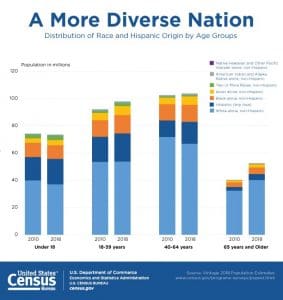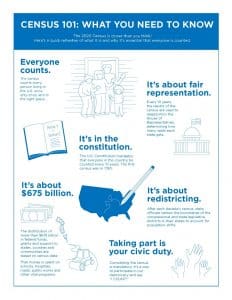 American Indian and Alaska Natives are the ethnic group with the highest undercount of any defined by the Census Bureau. According to the 2010 Census, roughly 26 percent of American Indians live in hard-to-count census tracts. More than 80 percent of reservation lands are ranked among the country’s hardest-to-count areas.
American Indian and Alaska Natives are the ethnic group with the highest undercount of any defined by the Census Bureau. According to the 2010 Census, roughly 26 percent of American Indians live in hard-to-count census tracts. More than 80 percent of reservation lands are ranked among the country’s hardest-to-count areas.
The Census Bureau reported an undercount of American Indians and Alaska Native populations in the last three Censuses. In 1990, there was a 12.2 percent undercount of American Indians on reservations, a 0.7 percent undercount in 2000, and a 4.9 percent undercount in the 2010 Census.
The bureau is busy hiring people from within their own communities, which Indian Country Today says is critical: “Native American and Alaskan Native communities have been historically undercounted. So hiring people from the actual communities they are familiar with could help produce a more accurate count.”
The first official count of the 2020 Census will take place in Tooksook Bay, Alaska, in January next year. Native American and Alaskan Native communities are at risk of receiving little resources if the census is inaccurate.
Although most of the funding comes from the treaty obligation, the government uses Census data to determine how much. Census data determines how $675 billion of federal funding is distributed, which communities need attention and resources from the government and private sectors, as well as schools, housing, Indian Health Service and business investments. George Washington University’s “Counting for Dollars 2020” study estimates that for the 16 large federal programs, the loss comes to $1,838 per person.
Census data is also used to help redraw district lines so the number of congressional seats in the U.S. House of Representatives matches the population correctly. Past undercounts of Native populations have deprived hundreds of thousands of American Indians of their voice in government.
 Every household will have the option of responding online, by mail or by phone. Nearly every household will receive an invitation to participate in the 2020 Census from either a postal worker or a census worker. While the majority will receive their census invitation in the mail (around March 12-20, 2020), almost 5 percent will get their invitation when a census taker drops it off.
Every household will have the option of responding online, by mail or by phone. Nearly every household will receive an invitation to participate in the 2020 Census from either a postal worker or a census worker. While the majority will receive their census invitation in the mail (around March 12-20, 2020), almost 5 percent will get their invitation when a census taker drops it off.
In these areas, most households may not receive mail at their home’s physical location (like households that use PO boxes or areas recently affected by natural disasters). Less than 1 percent will be counted in person by a census taker, instead of being invited to respond on their own. This is implemented in remote areas like parts of northern Maine, remote Alaska and in select American Indian areas that ask to be counted in person.
Leave a Reply